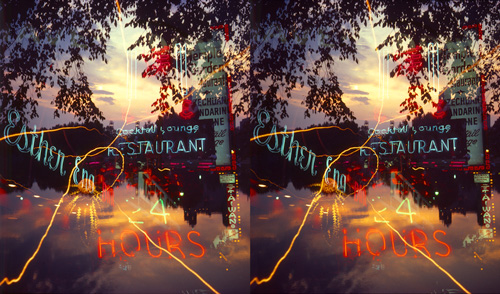the dogs were lean and silver
“They were attended by a pack of greyhound dogs and the dogs were lean and silver in color and they flowed among the legs of the horses silent and fluid as running mercury and the horses paid them no mind at all.”
the signature of Cassiopeia
—Cormac McCarthy, All the Pretty Horses, 1992.
he drank it black
“His father stirred his coffee a long time. There was nothing to stir because he drank it black. He took the spoon and laid it smoking on the paper napkin and raised the cup and looked at it and drank.”
pure Mocha coffee
“. . . he invited the strangers in to his house, where his two sons and daughters offered them several kinds of sherbet which they had made themselves, as well as drinks flavoured with candied lemon peel, oranges, lemons, citrons, pineapples, and pistachios, and pure Mocha coffee unmixed with the bad coffee you get from Batavia and the West Indies.”
35 Years in 3-D
35 Years in 3-D, a retrospective of stereoscopic 3-D art by Gerald Marks, will be on display September 3rd through September 17th at New York City’s School of Visual Arts. According to Greg Dinkins, the genius behind the New York Stereoscopic Society, the show will feature “early printed anaglyph work; polarizing projection of 3-D his photography, old and new; lenticular prints, transparencies, & computer screen; a Professor Pulfrich’s Universe shadow room; his computer generated hologram done at the MIT MedialLab; and excerpts from his 3-D videos for the Rolling Stones.” Wow. If I happened to be in the greater NYC area, I wouldn’t miss it.
X
—David Barringer, There’s Nothing Funny about Design, 2009.
red and yellow
—David Barringer, There’s Nothing Funny about Design, 2009.
Red Axanthic. Blonde Pastel. Lemon Blast.
—David Barringer, There’s Nothing Funny about Design, 2009.
the “Chameleon”
—David Barringer, There’s Nothing Funny about Design, 2009.
the white summer
“Rising inside Grady was an ungovernable laughter, a joyous agitation which made the white summer stretching before her seem like an unrolling canvas on which she might draw those first rude pure strokes that are free.”
